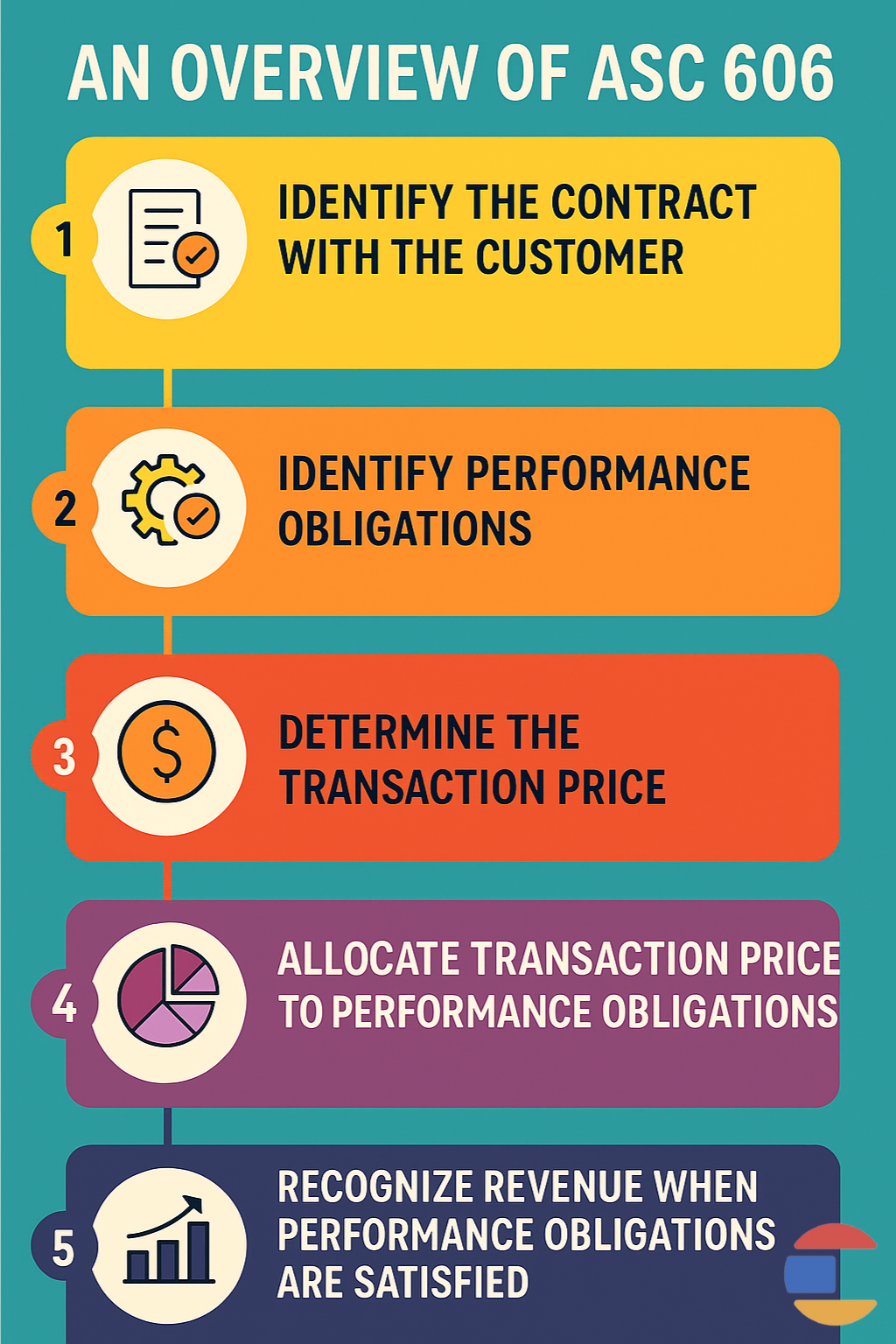ASC 606 Revenue Recognition: 2025 Updates Every Startup Must Know Now
.png)

Enter your info to receive the guide instantly.
The Accounting Standards Codification 606 (ASC 606) transformed how companies recognize revenue by establishing a comprehensive five-step model that determines when and how much revenue can be recorded.
This standard requires businesses to identify performance obligations, determine transaction prices, and recognize revenue as those obligations are satisfied, thereby replacing the previous patchwork of industry-specific guidelines.
For startups, 2025 is an important inflection point, as recent regulatory updates and enforcement actions have intensified scrutiny of revenue recognition practices.
The Financial Accounting Standards Board has issued new clarifications specifically targeting digital business models, subscription services, and multi-element arrangements.
Proper ASC 606 compliance impacts your startup's valuation, fundraising prospects, and audit readiness.
Startups with clean revenue recognition processes command premium valuations and experience smoother due diligence processes, while those with compliance gaps face delayed funding rounds, regulatory penalties, and potential restatements.
Keep reading to discover the ASC 606 revenue recognition updates you must know in 2025.
An Overview of ASC 606
ASC 606 establishes a five-step framework that startups must follow for all customer contracts. This includes:

Step 1: Identify the Contract with the Customer
The contract must be approved by both parties, have commercial substance, and create enforceable rights and obligations. For startups, this includes SaaS agreements, professional services contracts, and software licensing deals.
Step 2: Identify Performance Obligations
Performance obligations are promises to transfer goods or services to customers. Startups often have multiple performance obligations within a single contract, such as software access, implementation services, and ongoing support.
Step 3: Determine the Transaction Price
The transaction price is the amount of consideration a company expects to receive. This includes fixed fees, variable considerations like usage-based pricing, and any significant financing components common in startup subscription models.
Step 4: Allocate Transaction Price to Performance Obligations
When multiple performance obligations exist, startups must allocate the total transaction price based on standalone selling prices. This step is complex for bundled software and service offerings.
Step 5: Recognize Revenue When Performance Obligations are Satisfied
Revenue recognition occurs when control of goods or services transfers to the customer, either at a specific time or over time. For SaaS startups, this usually happens over the subscription period.
Major 2025 Updates and Clarifications
2025 brings several updates that impact how startups handle revenue recognition. These changes address common pain points and provide the clarity emerging businesses need to manage complex revenue streams.
New Guidance on Variable Consideration and Constraint Application
ASC 606 variable consideration rules have been refined in 2025, especially around constraint application methods. The updated guidance provides clearer frameworks for estimating variable consideration while maintaining compliance with the "highly probable" threshold.
The main changes for startups include the following:
- Enhanced estimation methods: New guidance allows for more sophisticated probabilistic approaches when calculating variable consideration. This is beneficial for SaaS companies with usage-based pricing models
- Refined constraint application: The constraint now applies more granularly to specific components of variable consideration rather than entire arrangements, thereby enabling startups to recognize revenue more accurately for multi-tier subscription models
- Improved documentation requirements: Companies must now maintain detailed records showing how they assess the constraint at each reporting period, creating better audit trails for investor due diligence
A SaaS startup offering tiered pricing with overage fees can now better estimate and recognize revenue from variable components while maintaining appropriate constraints on uncertain elements. This change benefits companies with freemium models transitioning users to paid tiers.
Updated Treatment of Contract Modifications in SaaS Environments
The 2025 updates address contract modifications in software-as-a-service environments, recognizing the unique challenges these businesses face with frequent plan changes, upgrades, and customizations.
SaaS-specific modifications include:
- Prospective modification treatment: New guidance clarifies when SaaS contract modifications should be treated prospectively versus requiring cumulative catch-up adjustments
- Bundle vs. separate contract determination: Enhanced criteria help determine when subscription upgrades create new performance obligations versus modifying existing ones
- Mid-term pricing changes: Clearer guidance on handling promotional pricing, discount applications, and subscription tier changes during contract periods
Contract modifications in SaaS environments now follow more predictable patterns. When a customer upgrades from a basic to a premium plan mid-contract, companies can more easily determine whether this creates a separate contract or modifies the existing arrangement.
This clarity reduces revenue recognition complexity and improves financial forecasting accuracy.
Enhanced Disclosure Requirements for Revenue Streams
2025 has more disclosure requirements to provide stakeholders with better visibility into revenue composition and risk factors. These enhanced disclosures require more detailed qualitative and quantitative information about revenue streams and their underlying uncertainties.
The new disclosures include:
- Revenue stream disaggregation: More granular breakdown of revenue by product line, customer type, and contract duration
- Performance obligation details: Enhanced descriptions of when and how companies satisfy performance obligations
- Variable consideration sensitivity: Quantitative analysis showing how changes in estimates would affect recognized revenue
- Contract modification frequency: Disclosure of modification patterns and their revenue impact
While these disclosures create additional reporting burdens, they also provide competitive advantages during fundraising and due diligence processes. Investors value transparency in revenue recognition practices, and comprehensive disclosures demonstrate operational maturity and financial sophistication.
Clarifications on Principal vs. Agent Considerations for Platform Businesses
The increase in platform and marketplace business models has prompted significant clarification in principal versus agent determinations.
The updated guidance emphasizes that entities acting as principals recognize revenue gross, while agents recognize revenue net, with new specific indicators for digital platforms.
Platform-specific indicators include the following:
- Control assessment framework: Enhanced three-part test focusing on inventory risk, pricing discretion, and customer relationship ownership
- Digital marketplace considerations: Specific guidance for companies facilitating transactions between third parties
- Service provider arrangements: Clearer distinction between platform services and direct service provision
The main control indicators for platforms include the following:
- Primary responsibility: Whether the platform has primary responsibility for fulfillment and customer satisfaction
- Pricing authority: Level of discretion in setting prices for goods or services
- Credit risk: Exposure to credit risk for customer receivables
- Supplier selection: Control over supplier selection and management
For instance, a startup operating a software marketplace must evaluate whether it controls the software before transferring it to customers. If the platform just connects buyers and sellers, taking a commission, it likely acts as an agent and recognizes revenue net.
However, if it curates products, provides customer support, and handles refunds, it may qualify as a principal and recognize gross revenue.
Startup-Specific Impact Areas
ASC 606 creates certain challenges for startups across different business models. It’s important you understand how the standard applies to your specific revenue streams to ensure accurate financial reporting and maintain investor confidence.
Freemium and Usage-Based Pricing Structures
The free tier usually doesn't constitute a separate performance obligation since no consideration is exchanged, but conversion tracking becomes critical for revenue forecasting.
Usage-based pricing models require startups to:
- Recognize revenue as usage occurs, not when invoiced
- Implement robust tracking systems to capture actual consumption
- Handle variable consideration constraints when usage patterns are unpredictable
- Address potential refunds or credits for service level agreement breaches
Consumption-based billing requires real-time revenue recognition capabilities that many startup accounting systems lack. This often necessitates significant process automation investments earlier than anticipated.
Multi-Element Arrangements and Bundled Services
Startups offering bundled software packages must carefully identify different performance obligations within each contract. Common multi-element scenarios include:
- Software licenses combined with implementation services
- Training and support bundled with core platform access
- Hardware provisioning alongside software subscriptions
- Third-party integrations included in service packages
The main challenge is determining standalone selling prices for each element when startups haven't historically sold components separately. ASC 606 requires observable prices, adjusted market assessments, or cost-plus margin approaches.
Contract bundling strategies can have huge impact on revenue recognition timing. Startups should evaluate whether bundling accelerates or delays revenue recognition compared to separate contracts.
Marketplace and Platform Revenue Recognition
Platform business models face the principal versus agent determination under ASC 606. Startups must evaluate whether they control goods or services before transferring to customers.
The main indicators for marketplace revenue recognition include the following:
- Primary responsibility for fulfilling customer promises
- Inventory risk before customer purchase
- Discretion in establishing prices for goods or services
- Credit risk for customer receivables
Platform startups operating as agents recognize only commission revenue, while those acting as principals recognize gross transaction values. This determination dramatically impacts reported revenue figures and growth metrics.
Payment processing timing also affects revenue recognition. Marketplace platforms must differentiate between facilitating payments (agent activity) and processing payments as a primary service (principal activity).
Professional Services Combined with Software Licenses
Startups offering professional services with software face complex performance obligation identification challenges. Common arrangements include:
- Custom software development with ongoing license rights
- Implementation consulting bundled with SaaS subscriptions
- Training services included in enterprise software deals
- Ongoing support combined with perpetual licenses
The most important question is whether professional services are different from software licenses. Services that customize or modify software may not be separately identifiable, thereby requiring combined revenue recognition treatment.
Time and materials billing for professional services usually recognizes revenue as services are performed, but fixed-fee arrangements require careful progress measurement to ensure accurate revenue timing.
Startups must also consider intellectual property licensing implications when custom development creates ongoing rights. Revenue recognition may comprise upfront license delivery and ongoing performance obligations.
Implementation of Best Practices for ASC 606 Revenue Recognition
Implementing ASC 606 revenue recognition standards doesn't have to affect your startup's growth. Here are strategies you can use to build compliant processes that strengthen your financial operations and investor confidence.
Building Robust Revenue Recognition Processes from the Ground Up
Creating effective ASC 606 processes starts with understanding your unique revenue streams and business model complexities.
- Map every customer touchpoint where revenue recognition decisions occur, from initial contract negotiations through service delivery and renewals.
- Establish clear documentation standards for all revenue-generating contracts. This includes standardized contract templates, approval workflows, and detailed performance obligation identification procedures. Your documentation should be thorough enough that any team member can understand the revenue recognition rationale months later.
- Design scalable workflows that can handle increased transaction volumes as your startup grows. Consider how your processes will function when you're processing 10x or 100x more contracts.
- Create decision trees and playbooks for common revenue recognition scenarios your startup encounters. Documented decision-making processes ensure consistency across your team.
Technology Solutions and Automation Tools for Revenue Recognition
Manual revenue recognition processes become unsustainable as startups scale. The right technology stack can automate routine decisions while flagging complex scenarios for human review.
- Revenue recognition software platforms like Zuora RevPro, Oracle Revenue Management, or NetSuite Advanced Revenue Management can automate the five-step ASC 606 model for standard transactions. These tools integrate with your existing CRM and ERP systems to create seamless data flows.
- Contract lifecycle management (CLM) systems help standardize contract creation and approval processes while maintaining audit trails. Tools like DocuSign CLM or Ironclad can flag non-standard terms that might affect revenue recognition timing.
- Business intelligence and reporting tools provide real-time visibility into revenue recognition impacts. Dashboards showing deferred revenue balances, performance obligation statuses, and revenue forecasts help leadership make informed decisions.
- Integration capabilities are crucial for startup tech stacks. Your revenue recognition tools should connect seamlessly with Salesforce, HubSpot, QuickBooks, or whatever core systems drive your business operations.
Cross-Functional Team Coordination: Sales, Finance, and Legal
ASC 606 compliance requires unprecedented collaboration between traditionally siloed departments. Breaking down these barriers early prevents costly mistakes and ensures consistent application of revenue recognition principles.
- Sales team training and enablement is important since revenue recognition relies on contract terms negotiated during the sales process. Train your sales representatives to recognize terms that trigger complex revenue recognition scenarios, such as variable pricing, free trial periods, or bundled service offerings.
- Finance and accounting alignment ensures your team understands the technical requirements and business implications of ASC 606. Regular training sessions on new guidance updates and scenario-based workshops help maintain expertise across your finance organization.
- Legal review processes should include revenue recognition impact assessments for all contract templates and non-standard agreements. Your legal team needs to understand how seemingly minor contract language changes can affect revenue timing and amounts.
- Regular cross-functional meetings create forums for discussing complex revenue recognition scenarios. Monthly or quarterly sessions where sales, finance, and legal teams review challenging contracts ensure consistent interpretation and application of ASC 606 principles.
- Escalation procedures should clearly define when and how to involve subject matter experts in unusual situations. Having predefined escalation paths prevents delays in contract approvals while ensuring compliance with revenue recognition standards.
Regular Review and Update Procedures
ASC 606 compliance isn't a one-time implementation project; it requires regular maintenance and continuous improvement as your business evolves and accounting guidance develops.
- Quarterly process reviews should evaluate the effectiveness of your revenue recognition procedures. Analyze processing times, error rates, and stakeholder feedback to identify improvement opportunities. These reviews also ensure your processes remain aligned with business model changes.
- Annual policy updates incorporate new accounting guidance, lessons learned from implementation experience, and changes in your business operations. Schedule annual reviews of your revenue recognition policies to ensure they remain current and comprehensive.
- Continuous training programs keep your team current on ASC 606 requirements and internal procedures. New hire onboarding should include comprehensive revenue recognition training while existing team members need regular updates on policy changes and best practices.
- Performance metrics and KPIs help monitor the condition of your revenue recognition processes. Track metrics like contract processing times, revenue recognition adjustments, and audit findings to identify trends and potential issues before they become significant problems.
- External benchmarking against industry peers and best practices ensures your startup's approach remains competitive and compliant. Participate in industry forums, attend accounting conferences, and engage with professional networks to stay current on emerging practices and common challenges.
- Technology upgrade planning should anticipate your startup's growth and needs. Regular assessments of your revenue recognition technology stack help identify when upgrades or replacements become necessary to maintain efficiency and compliance.
Accelerate Your ASC 606 Implementation with Fractional CFO Expertise
Implementing ASC 606 compliance doesn't have to drain your internal resources or derail your growth. Many successful startups maximize fractional CFO expertise to manage complex revenue recognition requirements while focusing on the main business objectives.
Chore acts as your fractional CFO and helps you with ASC 606 implementation and ongoing compliance management. As your fractional CFO, Chore can establish robust revenue recognition processes, implement appropriate technology solutions, and train your cross-functional teams on compliance requirements.
We also provide the strategic financial leadership you need to build investor-ready revenue recognition practices without the cost commitment of a full-time executive hire. This approach is valuable during fundraising periods when investors scrutinize your revenue quality and compliance documentation.
Schedule a consultation with Chore to learn more about how we can enhance your revenue recognition process and accelerate your path to investor-ready financial operations.
FAQs
What is ASC 606 revenue recognition?
ASC 606 (Accounting Standards Codification Topic 606), titled “Revenue from Contracts with Customers,” is the revenue recognition standard issued by the Financial Accounting Standards Board (FASB) that provides a comprehensive framework for how companies recognize revenue from customer contracts. It replaced previous U.S. GAAP guidelines and aims to improve comparability, consistency, and transparency across industries and financial statements.
What is the difference between ASC 606 revenue recognition and IFRS 15?
ASC 606 (U.S. GAAP) and IFRS 15 (International Standard) both follow the same 5-step revenue recognition model but differ in several areas:
- Collectibility Threshold: ASC 606 requires high certainty (≈75–80%) of collecting payment while IFRS 15 uses a lower threshold (more likely than not, >50%).
- Noncash Consideration: ASC 606 fixes the value at contract inception while IFRS 15 allows flexibility in the timing of valuation.
- Shipping and Handling: ASC 606 allows companies to treat post-control shipping as fulfillment cost while IFRS 15 requires treating it as a separate performance obligation if distinct.
- Contract Costs: ASC 606 permits broader capitalization and does not allow impairment reversals while IFRS 15 applies stricter capitalization rules and allows impairment reversals.
- Onerous Contracts: Only IFRS 15 requires recognizing losses (onerous provisions) while ASC 606 has no general requirement.
- Contract Combination: IFRS 15 combines contracts more broadly, while ASC 606 uses stricter conditions.
Is ASC 606 part of GAAP?
Yes, ASC 606 is part of U.S. GAAP (Generally Accepted Accounting Principles). ASC stands for Accounting Standards Codification, which is the system the Financial Accounting Standards Board (FASB) uses to organize U.S. GAAP. ASC 606 is the authoritative guidance within U.S. GAAP for how companies recognize revenue. It replaced previous revenue recognition rules (like SAB 104 and ASC 605) and aligned U.S. standards more closely with international standards (IFRS 15).
Chore's content, held to rigorous standards, is for informational purposes only. Please consult a professional for specific advice in legal, accounting, or other expert areas.





.png)
.png)
.png)